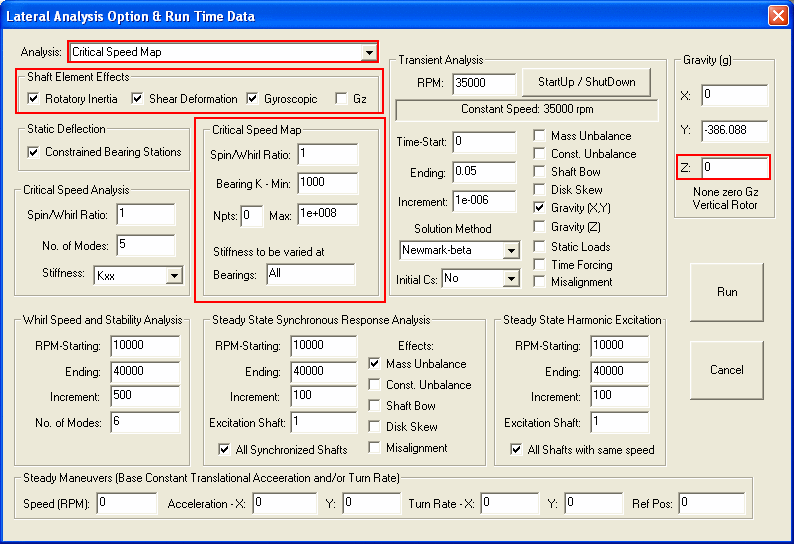
The Critical Speed Map calculates the undamped critical speeds for a given range of bearing stiffnesses. The flexible supports were ignored in the Critical Speed Map Analysis before Ver 16.20. That is, the bearings can not be in series before Ver 16.20. The intention for the Critical Speed Map is to examine the rotor flexibility with the support stiffness. So, the bearing stiffness used here is the total equivalent support stiffness if there are bearings in series. However, one may use this analysis to study the effect of that particular bearing stiffness on the critical speed. So, after Ver 16.20, this restriction has been removed. That is, now, it allows bearings in series. However, if you would like to vary the flexible support stiffness, then create a bearing for the flexible support stiffness in the bearing data, and only enter the flexible support mass in the support data. A check box “Allow Bearings in Series” is added for this option. If the box is checked, then it will allow bearings in series (new feature in Ver 16.20), if the box is unchecked, any flexible supports are ignored, just like old versions.
In Version 6.0 and above, it allows you to vary the stiffnesses of several selected bearings and hold the remaining bearing stiffnesses fixed. In Version 5.0 and below; however, all the bearings are varied with the assumption that all the bearings are identical. This enhanced capability allows you to analyze the multiple shaft systems.
The run time data required in this analysis are described below:
Spin/Whirl Ratio
This parameter has been explained in the Critical Speed Analysis.
Bearing K, Min and Max
These two stiffness values (minimum and maximum) define the stiffness range for the analysis.
Npts
This number defines the number of stiffness points between the specified stiffness range (Kmin and Kmax) that will be used in the calculation. If Npts = 0, then it will be reset to be:

Stiffness to be varied at Bearings
If the input is zero (0) or All, then all the bearings will be assumed to be identical and their stiffnesses will be varied according to the Kmin, Kmax and Npts inputs. Or, you can select up to 5 bearings to be varied by using the Kmin, Kmax and Npts inputs and hold the remaining bearing stiffnesses constant by using the regular bearing stiffnesses (Kxx) data provided in the bearing input tab. The bearings to be varied are input as bearing numbers (not bearing stations) and separated by commas. For example, the string 1,3,4 indicates that the bearing numbers 1, 3, and 4 are to be varied. This allows you to skip the bearings, which are not REAL but modeled as bearings, such as pseudo bearings caused by aerodynamic cross-coupling, etc..

For sample outputs, click Critical Speed Map.
Copyright © 2014-2017